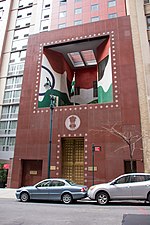Sushi Yasuda
1999 establishments in New York CityJapanese restaurants in ManhattanMichelin Guide starred restaurants in ManhattanMidtown ManhattanRestaurants established in 1999 ... and 2 more
Sushi restaurants in New York (state)Use mdy dates from January 2013

Sushi Yasuda is a Japanese sushi restaurant located at 204 East 43rd Street (between Second Avenue and Third Avenue) in the Midtown East area of Manhattan, New York City. The restaurant was founded in 1999 by its former chef, Naomichi Yasuda of Chiba Prefecture, who returned to Japan in January 2011 to open a new restaurant in Tokyo, Sushi Bar Yasuda. It is owned by Shige Akimoto, and Scott Rosenberg. The current chef is Mitsuru Tamura.
Excerpt from the Wikipedia article Sushi Yasuda (License: CC BY-SA 3.0, Authors, Images).Sushi Yasuda
East 43rd Street, New York Manhattan
Geographical coordinates (GPS) Address Nearby Places Show on map
Geographical coordinates (GPS)
| Latitude | Longitude |
|---|---|
| N 40.751242 ° | E -73.973649 ° |
Address
East 43rd Street 202
10017 New York, Manhattan
New York, United States
Open on Google Maps









